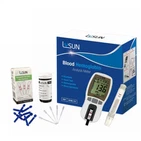Blood glucose meters have been a lifesaver for millions of people with diabetes. They allow individuals to monitor their blood glucose levels easily and accurately from the comfort of their own home. However, like all medical devices, blood glucose meters have a lifespan. It is important to understand how long a blood glucose meter can be used and when it may need to be replaced.
The lifespan of a blood glucose meter can vary depending on the brand and model. However, most blood glucose meters have a lifespan of two to three years. After this period, the accuracy of the readings may decline, which can be dangerous for people with diabetes who rely on these readings to manage their condition.
To ensure accuracy, it is also important to check the expiration date of the test strips. Test strips can expire anywhere from 3 to 6 months after opening the package, so it is essential to check the expiration date before using them. Using expired test strips can result in inaccurate readings, which can lead to incorrect dosing of insulin or improper management of diabetes.
It is also important to note that factors such as temperature, humidity, and exposure to light can affect the accuracy of blood glucose meters. If a meter is dropped or exposed to extreme temperatures, it may need to be replaced before its expiration date.
To ensure accurate readings and to protect the health and safety of individuals with diabetes, it is important to replace blood glucose meters and test strips as recommended by the manufacturer. This may mean replacing the meter every two to three years or sooner if necessary.
In conclusion, blood glucose meters are an essential tool for people with diabetes to manage their condition. Understanding the lifespan of these devices and properly maintaining them is crucial to ensure accurate readings and proper management of diabetes. Replace your blood glucose meter and test strips as directed by the manufacturer to ensure your safety and peace of mind.




